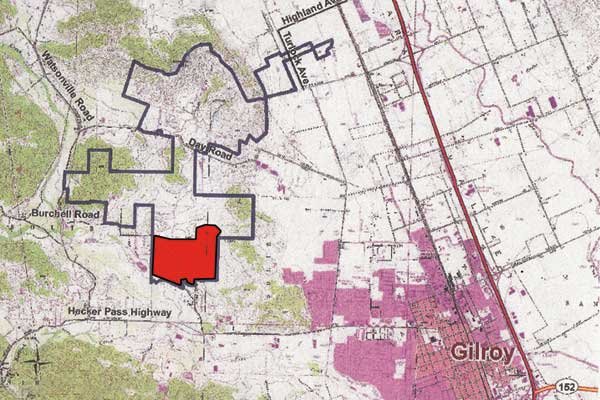An expensive and long-term application to add 285 idyllic acres
to the city’s northwest quad is moving forward at the hands of a
well-connected Bay Area developer, and the same residents who
halted plans for a quarry in the area last year are again rallying
to stop the potential development.
An expensive and long-term application to add 285 idyllic acres to the city’s northwest quad is moving forward at the hands of a well-connected Bay Area developer, and the same residents who halted plans for a quarry in the area last year are again rallying to stop the potential development.
The rolling swath of land straddling Burchell Road north of Hecker Pass represents a 15-percent sliver of the 2,014 acres the Lucky Day Partnership proposed to annex 1.5 years ago. City planners said catapulting development so far would unreasonably strain Gilroy’s infrastructure and emergency services, and since then the applicant, John Vidovich, and land owner, Gary Gillmor, have scaled back the scope of their annexation request.
Their application once imagined annexing 1,700-plus acres of open space, 248 acres of low-density housing and the remaining 76 acres for public facilities and park space. The new application proposes the city include 23 acres of open space, 41 acres for up to 138 homes and 221 acres of park land that could accommodate nine more holes at the Gilroy Golf Course. And those aren’t the only carrots.
“By allowing approximately 285 acres to be brought into the city,” the application reads, “the client will be in a financial position to dedicate approximately 1,729 acres of property towards an environmental mitigation bank.” That would essentially give Gilroy clout when it comes to the evolving Santa Clara Valley Habitat Conservation Plan, a long-range blueprint county officials are creating that will hinge future development on the protection of more than 500,000 acres, mostly in South County. Lucky Day could bring 1,729 acres to the table and offer local developers a nearby sanctuary from which to purchase mitigation credits.
“It’s similar to a national park that’s dedicated through the government for the environment,” Vidovich said. “This would be an advantage for anyone who has to mitigate.”
But Ken Pauley, a Burchell Road resident who gives regular updates on the application to dozens of neighbors via his Yahoo! group, recently wrote in an e-mail, “The incentive is obviously to try and lure with a bunch of open space, but of course the most valuable part of the property is what would be used for housing in order to preserve the rest of the land for open space.”
Still, Vidovich the group had “no imminent plans” to build anything, and despite the application’s scope, development is not guaranteed because the city already has five years worth of vacant land earmarked for houses. Plus, the next time the council will dole out housing permits is 2014, when officials have predicted stagnant developers who now have housing rights will start building. In the meantime, Vidovich and Gillmor want to get their ducks in a row.
“We’re sort of taking advantage of the fact that a lot of people aren’t busy now,” Vidovich said, adding that “Gilroy is better off to have local control over this land.”
To bring in the 285 acres that county tax records value at $871,818, the applicant must pay $23,703 in fees and more than $110,000 for an environmental impact report and then receive a thumbs-up from the city Planning Commission, City Council and the Local Agency Formation Commission – a regional agency with veto power over annexation requests. LAFCO, which will consider three other annexation requests from Gilroy this summer, nixed a nearly identical proposal 11 years ago when the city offered to buy 218 acres from Gillmor for $3.1 million to expand the golf course. Afterward, Gillmor vowed to ultimately bring his land into local hands, not those in San Jose.
Although they feel in the dark at times, Pauley and other neighbors said they were confident councilmembers would hear their voices before LAFCO can even consider the proposal.
“I’m not terribly concerned because I don’t think it’ll make it past the city council,” Pauley said.
It’s too early to pass judgment on the proposal, Mayor Al Pinheiro said, and especially too early to consider adding nine holes to the city’s golf course given Gilroy’s financial straits.
“There’s so much else going on right now,” Pinheiro said. “We’ll let it go through the process and consider it when it comes to us, but there’s nothing I can say about it now because it’s too premature.”
If the annexation request makes it to LAFCO, though, residents have also worried that Vidovich may have too much control. But the former Santa Clara County Planning Commissioner and once high-ranking official in the state Republican Party – whose family and colleagues, along with Gillmor’s, have donated thousands to LAFCO commissioners over the years – said if he was really trying to pull strings, he would avoid turning the land over to Gilroy, where he has fewer strings to pull.
“This would put the land in the hands of Gilroy, where I have less influence,” Vidovich said. “Kind of ironic, right?”
State law disqualifies public officers from deciding on an issue if they received more than $250 from someone involved within the past 12 months. That clears LAFCO’s five regular commissioners, but if the matter comes before LAFCO before July 30, then County Supervisor George Shirakawa, an alternate LAFCO commissioner, could not vote because he received $4,500 from members of Vidovich’s family and $2,700 from Gillmor family members and employees of the family business as late as July 30, 2008.
Three employees at Gillmor & Associates gave County Supervisor and LAFCO Commissioner Don Gage $1,250 between 2004 and 2005. A Gillmor family member gave the supervisor $750 during the same period. In 2005, Gillmor’s daughter and the head of Gillmor & Associates, Lisa Gillmor, contributed $500, the legal maximum. Supervisor Liz Kniss, who also sits on the LAFCO board with Gage, received $500 from Vidovich’s father, Stephen John, in 2005 and an additional $250 from him in 2003.
Gillmor – who owns all of Day Ranch in partnership with his children and some 200 investors – also spent four years on the Santa Clara City Council beginning in 1965 and then became the mayor four years later and served until 1977. His daughter also sat on the Santa Clara council during the ’90s.
All this means Vidovich and Gillmor are ready to hear from residents like Pauley, whom the developers encouraged to get involved.
“You should only propose projects that are good for the community, and if this is bad for the community, then now’s the time to let us know,” Vidovich said.















